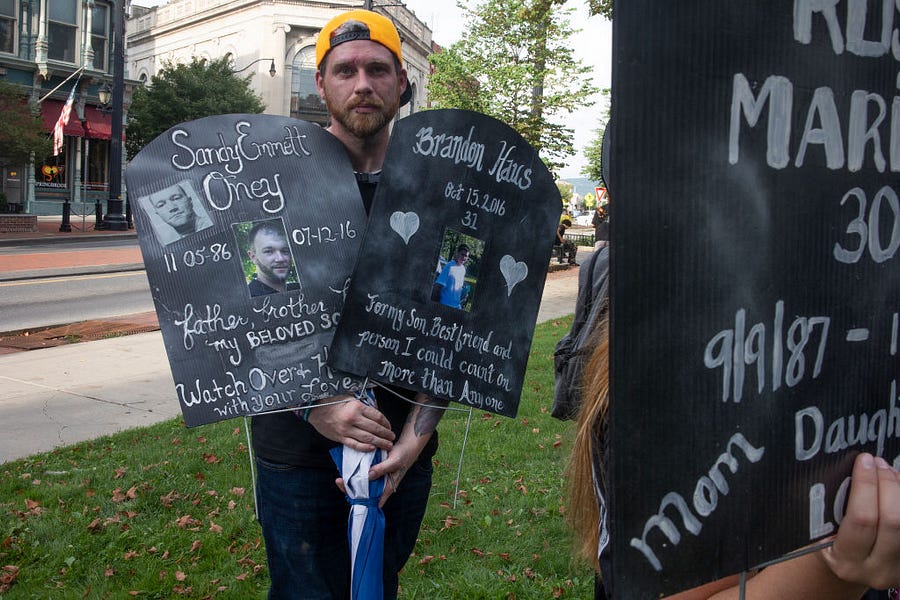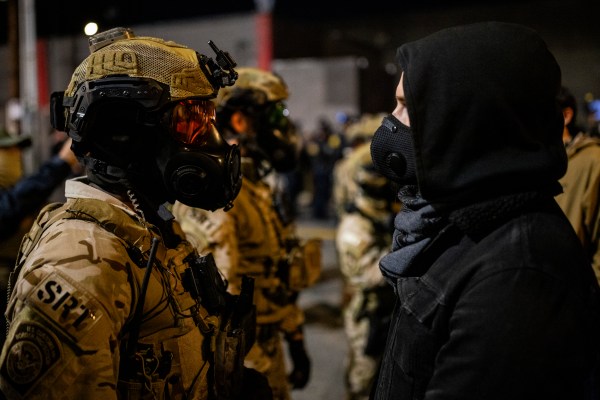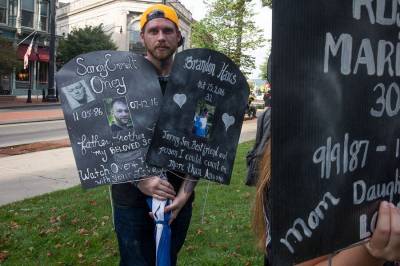While COVID-19 was devastating communities across the United States, a different destructive uptick in deaths went unnoticed. A new study from the National Institutes of Health shows that more adults between the ages of 18 and 65 perished from alcohol-related causes in 2020 than from COVID-19. This parallels earlier data from the Centers for Disease Control and Prevention that showed a large increase in the number of drug overdose deaths in the 12 months leading up to May 2020; the total was the highest ever recorded. In other words, it appears that the isolation caused by extended lockdowns led to an approximately 25 percent jump in alcohol-related deaths and a 38 percent jump in drug-related deaths.
These revelations follow a series of recent studies that show how communities and countries with higher levels of social trust, social capital, and social and emotional support fared better during the pandemic than those that did not. These social dynamics help explain why the United States did much worse than might be expected given its relatively strong pandemic preparedness. Our attempts to prepare for the next pandemic, including those plans emanating from the White House, are incomplete without a strategy to address America’s social fragility. A society is only as strong as its social connectedness, something COVID-19 vividly revealed. Places with a weak social fabric and low levels of interpersonal trust among citizens were not able to act collectively when necessary. Further, they could not provide the support people needed to withstand the negative side effects from pandemic measures such as lockdowns.
Such grim statistics remind us that the United States is unique in its mixture of material wealth and social decay. While many countries in Europe and Asia have income levels similar to us, they have far less social breakdown. Why? The relationships that bind us to one another are weaker in America than elsewhere—and weakening, even disintegrating.
Data support the uniqueness of our social situation. Whereas almost nine of every 10 children under 5 live with two parents (some of these cohabitating) in the European Union, only seven in 10 in our country do. The gap means that, accounting for their percentage of the American population, 5 million more young children live with only one parent or neither parent. Whereas suicide rates are declining almost everywhere in the world, they have been climbing in the U.S. for two decades. America has a slew of social indicators—from maternal mortality to drug overdose death rates to gun violence—that are in a class by themselves, far higher than other countries, especially in the developed world. As Anne Case, who with fellow Princeton University professor Angus Deaton sounded the alarm on rising deaths of despair, asks, “Why are people killing themselves in these ways in the United States, but not in other rich countries, which have also seen globalization and automation?”
Many initiatives and reforms have sought to heal these growing social ills, ranging from opportunity zones to healthcare reform, but despite often producing inspiring cases of individual success the efforts are clearly insufficient—and sometimes plainly wrong. They may even have a deleterious effect, weakening the very relationships people need for support and flourishing in the process. What explains this exceptionalism we wish we did not have?
What Explains American Exceptionalism?
Instead of “indivisible,” Americans might pledge themselves to one nation, ‘individual,’ with liberty and justice for all. Why? American culture is an outlier in its degree of individualism. This is most evident when examining cross-cultural analysis of how people think. While Westerners in general—and especially the secular middle and upper classes—stand out globally in terms of the individualistic orientation of their perceptions, behaviors, and motivations, Americans are extreme. Indeed, the most well-known study of such cultural differences concluded that while Westerners are “almost always sliding down one end of the human bell curve,” Americans are “exceptional even within the unusual population of Westerners—outliers among outliers.” This means that while Westerners may be WEIRD—Western Educated Industrial Rich Democracies—when compared to people from other societies, Americans are the “Weirdest People in the World.”
There are some historical reasons for our individualism—how we were settled, how much we were influenced by English mores, how we achieved independence, how we constructed our government, how diverse we have become, and how our national ideology has evolved. But there are also many what we might call “structural” or institutional factors that contribute greatly to why we are so much more individualistic than our peers. These are things that cannot be easily altered and understanding them will help us see why the U.S.’s social fragility is unique—and whether there is anything we can do about it.
Markets play a larger role in more aspects of American lives than most other countries, making relationships more transactional than most of the world can even imagine. For example, they play a deeper role in dating, sex, and marriage; our bandwidth for engaging neighbors; careers; and how we hire nannies and contractors for our homes. And whereas most cultures use myriad indicators to measure well-being and progress, Americans inevitably fall back on economics, as evidenced by the focus on getting ahead materially in the American dream, and Wall Street tickers in our daily news.
Our sprawling geography has long encouraged the dispersion of people. In great contrast to a country such as the Netherlands, we spread out across a wide terrain, always searching for a new horizon. Settlers went West looking for opportunity. Farmers moved far away in search of a better homestead. In more recent decades, people have abandoned what were the largest cities at the turn of the century—eight of the top 10 in 1950 have shrunk in the years since—to go south and west. Meanwhile, families everywhere moved to suburbs and exurbs looking for a larger property and house to call their own. The sprawl isolates and divides, weakening the bonds that tie us together.
Our dynamic economy, centralized federal government, and national university system have long encouraged the ambitious to uproot themselves from wherever they live and move to a handful of cities and neighborhoods where the affluent and influential congregate. Many regions suffer as a result, with the local place-based relationships that once predominated across our landscape withering and our population atomizing. Chris Arnade writes that “much of the back row of America, both white and black, is humiliated … The communities that provided pride are dying, and into this vacuum have come drugs.” This trend started sometime around World War I but has accelerated since the middle of the 20th century, paralleling trends on social breakdown.
Our highly educated have been trained to become more passionate about abstract ideas and advocacy directed toward specific and often national issues than investing in the often frustrating and labor-intensive work that community relationships and local institutions require. They are also busier than ever, with less spare time to invest in neighborhoods, churches, associations, and volunteer activities.
Despite America’s huge size and population and federal political system, government and philanthropy are surprisingly centralized, with funding patterns that constrain the development of local institutions. Whereas once our society was famous for the number and variety of social institutions in every city, town, and village—enriching relationships and communities in the process—today our civic society is dominated by large, hierarchical organizations tied to government or large philanthropic money coming far from where most people live. This has distorted the myriad social structures that once cultivated and mediated our interactions, leaving us rootless and disconnected.
While the U.S. is well-known for being more religious than other developed countries, its religious landscape often hampers the sustenance of traditional norms, such as those connected to marriage and the family. As argued by Ross Douthat in Bad Religion, many churches promote the prosperity gospel and cults of self-esteem while they “encourage our worst impulses.” Houses of worship compete for consumers in a way that debases doctrine. Heresy, not atheism, rules in many places. In addition, the rise of evangelicalism reflected and exacerbated our individualism and anti-establishment nature. As a result of these forces, some of our most religious places have the least stable family patterns—the opposite of what should be the case.
Next, let’s consider how modern urban planning has played an outsized role in shaping our physical landscape. America has a unique number of cities that were built or built up over the past century. Unlike most of the world, we have few legacy cities—New York, Philadelphia, Boston, Chicago, and San Francisco—built before the rise of the automobile and professional urban planners appeared on the scene. Working from a relatively clean slate, these have been built around the automobile and a rather antiseptic view of human habitats. Neighborhoods have become monofunctional rather than multifunctional, and class-based in a way they rarely were previously.
Our housing and transportation policies have similarly worked to divide and isolate. Cars, for example, may give us privacy and possibilities, but they also trap us in long commutes to work, encourage us to shop in impersonal malls and drive-thrus, and support lifestyles in which we have little time for our neighbors and neighborhoods. A recent ad for a housing development in Arizona boasted, “Far from the crowds yet close to convenience.” Building highways has always been a much higher priority for U.S. policymakers than subways and other investments that might make cities and close suburbs more attractive places to live. Housing policy often worked in a similar fashion, encouraging those who could to flee cities and concentrating the poor in particular neighborhoods within them.
Lastly, our society’s overemphasis on specialization and siloed thinking—a product of our education systems, the professionalization of our institutions, the centralization of government, and a focus on short-term, quantitative results—reduces our ability to think clearly about cross-cutting, comprehensive approaches to improving our social structures and the relationships they support. Programs focus on individuals rather than social contexts they are embedded in, and resolving specific problems rather than the cross-cutting causes of those problems. In many cases, they are undertaken in ways that weaken the very social structures and relationships that their ostensive outcomes depend on. Programs can, for example, draw the most talented people away from the very neighborhoods that need talent or disconnect community organizations from the residents they are meant to support by how they shift their attention to outside funding streams.
Many of these are interrelated. Our individualism drives many of our policies, which in turn encourage more isolation. But by breaking down the unique causes of our social fragility this way, we more easily grasp entry points for change—change that can encourage the development of stronger social bonds and the social structures that embed people in long term rather than transactional relationships. And many of these lend themselves to practical policies that can strengthen the ties that bind us all—reversing social breakdown in the process.
Of course, many of us have benefitted from these great changes even if we have less socially rich lives than they might have had otherwise. We may see the tradeoffs as beneficial. Indeed, some Americans—notably many women, middle- and upper-class persons of color, and others previously marginalized—are greatly empowered by the breakdown of the constraints our relationships used to impose on us. And, in general, we as a society have gained materially, with access to far more choice and comfort that once was the case.
However, the tradeoffs tend to benefit people of some classes and places more than others. While we are all dependent on our relationships in some form, lower-income people are much more dependent than others, explaining why they are significantly more affected by social breakdown than other parts of our society. While wealthier Americans can easily pay for childcare, spiritual advice, tutoring, and car and home repairs or compensate for a divorce, poor people cannot. And the vibrant social institutions that used to provide a social safety net—like the local church, ethnic association, and moms’ group—have significantly decayed.
At the same time, it would be wrong to assume that our social impoverishment affects only the most disadvantaged among us. Taking on irrevocable commitments and constraints is considered passé. Tying one’s destiny to a particular neighborhood—or a group or even another person—is considered behind the times. But that does not make such commitments wrong. They are, in fact, as essential to our personal wellbeing as they are to the health of our society. As John McKnight and Peter Block write, “if we don’t know our neighbors, aren’t active in local community life, pay for others to raise our children and service our elders, and try to buy our way into a good life, we pay a larger price. We produce, unintentionally as it might be, a weak family, a careless community, and a nation that tries hopelessly to revive itself from the top down.”
Bolstering Our Social Resilience Neighborhood by Neighborhood
What can we do to reduce our social fragility—to boost our social strength/resilience? As a start, we need to stop thinking that all we need to do is make a warmer, better argument than in the past, and society will heal itself. There are significant structural and institutional factors at work here, and only by addressing at least some of these is change likely to come about. While there are a few, such as geography and the religious landscape, that we can do little about, many others are excellent entry points for creative thinking.
We don’t need to invent “new” programs. On the contrary, we should be shifting existing activities such that they have a different impact on society—directly or indirectly yielding a greater appreciation, joy, and sense of responsibility in relationships and the institutions that nurture them. Place is key—relationships may be increasingly mediated virtually, but intimacy and trust depend first and foremost on in-person gatherings and regular engagement, day in and day out.
Here are some examples of what such shifts might look like:
Government authority over programs and money could be both shifted from national to local control and from hierarchical siloes to neighborhood-focused teams. Instead of sector-specific experts working distantly from those on the receiving end of programs, our cities and towns need generalists with a wide range of skills who are committed to a particular geography for an extended period of time. Then we could evaluate local teams based on the success of their neighborhoods, not the subsidies dished out, permits issued, roads completed, or boxes checked—as is typically the case today.
At the street level, urban planners could focus on promoting the kind of physical landscape that nurtures social cohesion as an integral part of its primary task, rather than ignoring how their designs influence common life, as is the case today. This would mean more densely built, multiclass, multifunction neighborhoods that encourage social interaction, civic-mindedness, and a sense of loyalty to one’s neighbors and community. Fountains, churches, local associations, commercial streets, libraries, parks, public buildings, and community centers all provide “third places” where we can interact with others from our zip code.
Who will benefit most from a place-based focus on social connections? Youth are arguably the most important demographic for any attempt to reverse social breakdown—they need to experience the joys of embodied life and communal institutions and not just see them as empty vessels and rhetoric. When summer camps and neighborhood after-school activities practice warm, welcoming engagement, it encourages stickier, longer-lasting commitments. Student government and clubs offering opportunities for serving the school and neighborhoods can impart the practice of stewardship and interpersonal responsibility.
Next, young people could consider national service that entailed work in our neighborhoods, and universities could emphasize the importance of contributing in-person in communities as much as they currently emphasize social change through advocacy. They could offer credit for time spent working in the neighborhoods most in need and offer midcareer training to people who would bring much needed management skills and access to resources to places without either.
These kinds of responses are all within our grasp. Our social fragility has garnered more and more attention as our social problems have multiplied. But while many lament the destruction caused, few have solutions for what might change the dynamic. A better understanding of what makes America exceptional can help us understand what might help. Charles Marohn, Jr., concludes that “America’s leaders seemingly believed that, if we strengthened the top, it would strengthen the bottom. This is an incorrect understanding. … Successful blocks beget successful neighborhoods. Prosperous neighborhoods make up a prosperous city. A strong and stable state is an assembly of strong and stable cities.”
Seth Kaplan, a leading expert on fragile states and societies, is a professorial lecturer in the Paul H. Nitze School of Advanced International Studies (SAIS) at Johns Hopkins University and a visiting fellow with the Mercatus Center's Program on Pluralism and Civil Exchange. He has worked in dozens of countries around the world.






Please note that we at The Dispatch hold ourselves, our work, and our commenters to a higher standard than other places on the internet. We welcome comments that foster genuine debate or discussion—including comments critical of us or our work—but responses that include ad hominem attacks on fellow Dispatch members or are intended to stoke fear and anger may be moderated.
With your membership, you only have the ability to comment on The Morning Dispatch articles. Consider upgrading to join the conversation everywhere.